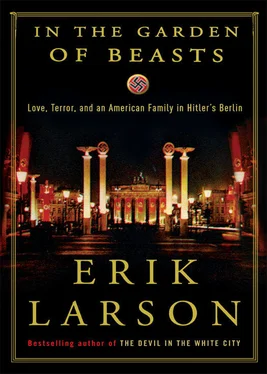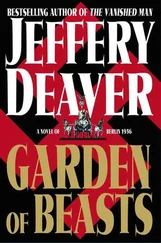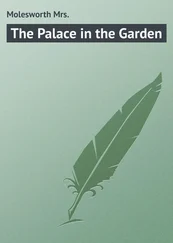I found the State Historical Society of Wisconsin to be a trove of relevant materials that conveyed a sense of the woof and weave of life in Hitler’s Berlin. There, in one locale, I found the papers of Sigrid Schultz, Hans V. Kaltenborn, and Louis Lochner. A short and lovely walk away, in the library of the University of Wisconsin, I found as well a supply of materials on the only UW alumna to be guillotined at Hitler’s command, Mildred Fish Harnack.
Most important, however, was my experience of Berlin itself. Enough of the city remains to provide a sense of the overall layout of things. Oddly enough the buildings of Göring’s Air Ministry survived the war largely intact, as did those of army headquarters, the Bendler Block. What I found most striking was how close everything was to the Dodds’ home, with every major government office an easy walk away, including Gestapo headquarters and Hitler’s chancellery, neither of which exists today. Where the Dodds’ home at Tiergartenstrasse 27a once stood there is now a vacant, overgrown lot surrounded by a chain-link fence. The Bendler Block is visible in the background.
I owe special thanks to Gianna Sommi Panofsky and her husband, Hans, son of Alfred Panofsky, the Dodds’ landlord in Berlin. The couple settled in Evanston, Illinois; Hans taught at Northwestern University. Mrs. Panofsky graciously provided me with the original floor plans for the house on Tiergartenstrasse (which a Northwestern journalism graduate student, Ashley Keyser, carefully secured and copied on my behalf). Mrs. Panofsky was a delight to talk to. Sadly, she died in early 2010 of colon cancer.
Above all, I thank my loyal early readers Carrie Dolan and her husband, Ryan Russell; my daughters, Kristen, Lauren, and Erin; and, as always, my wife and secret weapon, Christine Gleason, whose margin notes—complete with crying faces and trailing lines of zzzzzzz’s—once again proved indispensable. Thanks to my daughters also for their increasingly astute critiques of my manner of dress. I owe a huge debt to Betty Prashker, my editor of nearly two decades, and to John Glusman, whose deft hand guided this book to publication. Thanks also to Domenica Alioto for taking on tasks she should not have to take on, and Jacob Bronstein, who so ably straddles the boundary between Web and world. An extra huzzah to Penny Simon for her friendship and expertise at getting me to do things I don’t want to do; to Tina Constable for her confidence; and to David Black, my longtime agent, wine adviser, and great friend. Finally, a long, long hug to Molly, our lovely, sweet dog, who succumbed to liver cancer at the age of ten as my work on this book neared its end. In her last weeks, however, she did manage to catch a rabbit, something she had sought unsuccessfully to do for years. We miss her every day.
WHEN I WAS IN BERLIN a strange thing happened, one of those odd little moments of space-time congruity that always seem to occur when I’m most deeply immersed in researching a book. I stayed at the Ritz-Carlton near the Tiergarten, not because it was a Ritz but because it was a brand-new Ritz offering rooms at compellingly low come-hither rates. That the month was February helped also. On my first morning, too jet-lagged to do anything terribly ambitious, I set out for a walk and headed for the Tiergarten, with the vague idea that I’d walk until I found the Dodds’ address, unless I froze to death first. It was an icy, blustery morning, marked by the occasional appearance of flecks of snow falling at oblique angles. As I walked, I came upon a particularly interesting bit of architectural preservation—a large portion of the facade of an old bullet-pocked building standing behind a giant wall of glass. A bridgelike deck spanned the top of this facade and supported several stories of modern luxury apartments. Out of random curiosity, I walked to an informational plaque that identified the facade. It belonged to the Hotel Esplanade, where the Dodds stayed when they first arrived in Berlin. Here as well, also behind glass, was an inside wall of the Esplanade’s breakfast room restored to original condition. It was strange to see these architectural artifacts lodged behind glass, like giant, immobile fish, but also revelatory. For an instant I could see Dodd and Martha setting off to begin their days, Dodd heading north at a brisk clip to the Tiergarten for his walk to the embassy offices on Bendlerstrasse, Martha rushing south to meet Rudolf Diels at the old art school on Prinz-Albrecht-Strasse before a quiet lunch in some discreet locale.
The following notes are by no means exhaustive. I have been careful always to credit material quoted from other works and to annotate those facts and observations that for one reason or another cry out for attribution, such as Ian Kershaw’s revelation —Hubris , page 485—that one of Hitler’s favorite movies was King Kong . As always, for those readers who like reading footnotes—and there are many of you—I have included little stories and facts that did not fit the main narrative but that struck me as too interesting or compelling to omit. For this indulgence, forgive me.
The Man Behind the Curtain
1 It was common: For details of the Schachno case, see “Conversation with Goering,” unpublished memoir, 5–6; and Messersmith to Hull, July 11, 1933, and July 18, 1933, all in Messersmith Papers. See also cumulative report on assaults against Americans in Phillips to Roosevelt, Aug. 23, 1933, file no. 362.1113 /4 1 /2, State/Decimal.
2 “From the neck down”: Messersmith, “Conversation with Goering,” unpublished memoir, 6, Messersmith Papers.
3 “From the shoulder blades”: Messersmith to Hull, July 11, 1933, Messersmith Papers.
4 “I wish it were”: Messersmith to Phillips, June 26, 1933, Messersmith Papers.
5 Inauguration Day in 1933: The Twentieth Amendment, passed in 1933, moved the inauguration date from March 4 to the now familiar January 20, a measure to reduce the amount of time that an outgoing president would be a lame duck.
6 Incredibly, the new ambassador: For more detail than you’ll ever need about the shipping of Dodd’s car, see Howard Fyfe to Harry A. Havens, July 8, 1933; Herbert C. Hengstler to Dodd, July 10, 1933; and Paul T. Culbertson to Dodd, June 19, 1933, all in Box 40, W. E. Dodd Papers.
Chapter 1: Means of Escape
1 The telephone call: Dodd, Diary , 3.
2 Dodd also owned: “Farming Implements” and Survey, Box 59, W. E. Dodd Papers.
3 “The fruit is so beautiful”: William E. Dodd to Martha Dodd, Oct. 15, 1926, Box 2, Martha Dodd Papers.
4 “sudden surprise”: Dodd to Westmoreland Davis, June 22, 1933, Box 40, W. E. Dodd Papers.
5 he pleaded for heat: Dodd to Lester S. Ries, Oct. 31, 1932, Box 39, W. E. Dodd Papers.
6 “embarrassing”: Dodd to Charles E. Merriam, Aug. 27, 1932, Box 39, W. E. Dodd Papers.
7 “hard men”: Bailey, 6.
8 “Monk Dodd”: Dallek, 6.
9 Other students indulged: Ibid., 9.
10 “How helpless”: “Brief Note,” 6, Box 58, W. E. Dodd Papers.
11 “There was too much”: Ibid., 7.
12 at Randolph-Macon: Bailey, 35–36; Dallek, 31–32.
13 In October 1912: Dallek, 70; Dodd to Mrs. Dodd, March 26, 1930, Box 2, Martha Dodd Papers.
In this letter to his wife, composed one fine night while on his farm, Dodd wrote, “I am sitting by the dining room table in work-a-day clothes, the old-red sweater and the easy-slippers—a great oak log on the fire and a bed of hot coals three inches deep, all surrounded by white ashes. The old andirons (‘firedogs’ of my boyhood parlance) lean their solid black heads back in contented contemplation of their efficient service—the old red-brick fireplace as dignified as George Washington and the eighteenth century, when men had time to be dignified.”
Читать дальше












